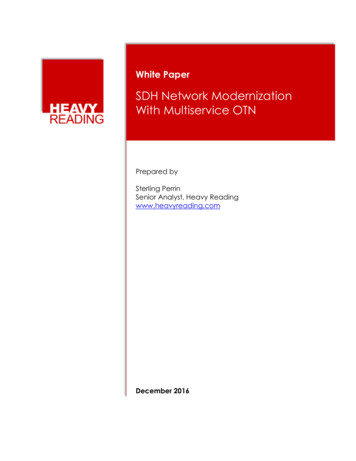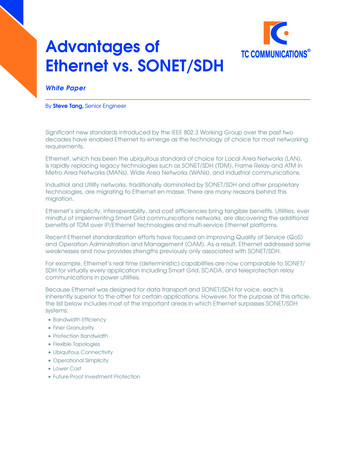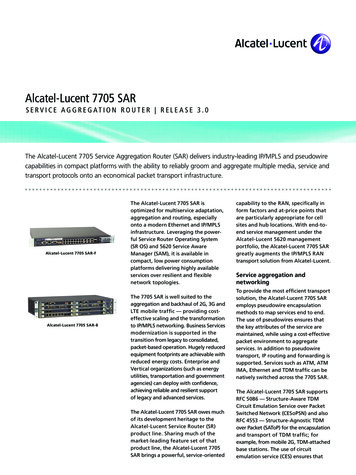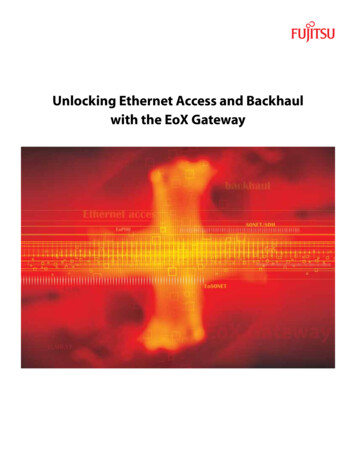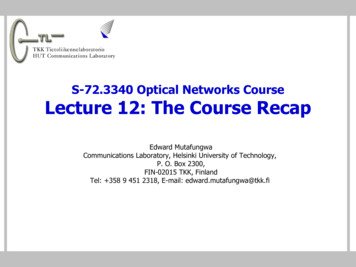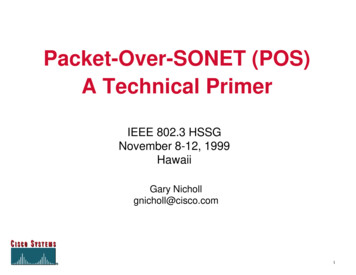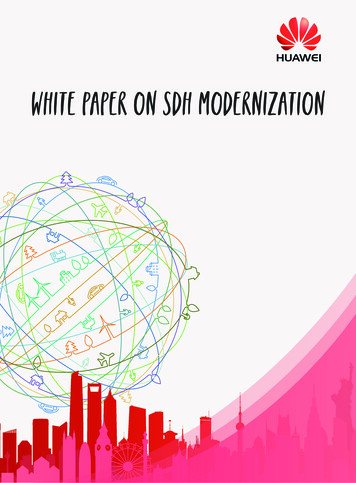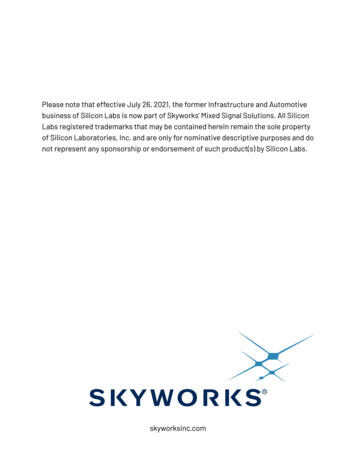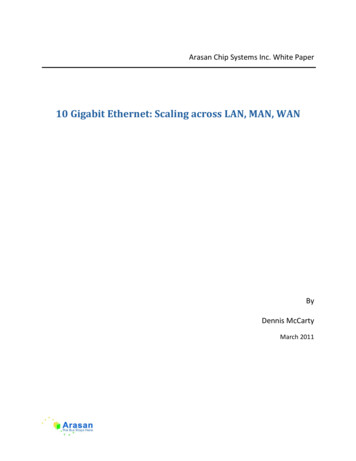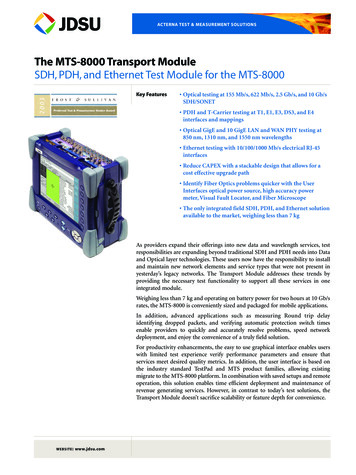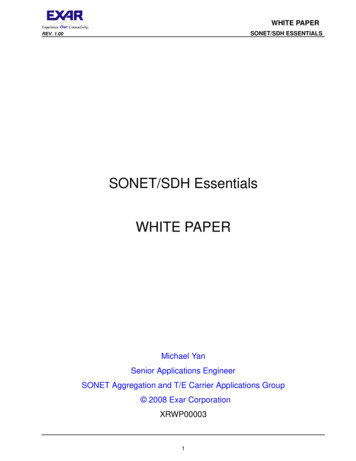
Transcription
WHITE PAPERSONET/SDH ESSENTIALSREV. 1.00SONET/SDH EssentialsWHITE PAPERMichael YanSenior Applications EngineerSONET Aggregation and T/E Carrier Applications Group 2008 Exar CorporationXRWP000031
WHITE PAPERSONET/SDH ESSENTIALSREV. 1.00TABLE OF CONTENTS1.0 THE BIRTH OF SONET AND SDH . 22.0 THE SONET STS FRAMING FORMATS . 3TABLE 1: SONET/SDH STANDARD DATA RATES . 32.1 THE STS-1 FRAMING FORMAT . 4FIGURE 1. THE STS-1 FRAME STRUCTURE . 42.2 THE SYNCHRONOUS PAYLOAD ENVELOPE . 5FIGURE 2. THE STS-1 SPE (SYNCHRONOUS PAYLOAD ENVELOPE) . 52.3 STS-3 FRAMING FORMAT AND HIGHER RATE STS-N . 6FIGURE 3. THE STS-3 FRAME . 6FIGURE 4. THE STS-3 FRAME AND STS-12 BYTE INTERLEAVING . 6FIGURE 5. THE STS-3 FRAME MUX . 7FIGURE 6. THE STS-3 FRAME DEMUX . 8TABLE 2: SONET/SDH STANDARD DATA RATES . 82.4 STS-3C FRAMING FORMAT AND HIGHER RATE STS-NC. 9FIGURE 7. THE STS-3C FRAME. 9TABLE 3: SONET/SDH STANDARD DATA RATES . 103.0 THE SONET SECTION OVERHEAD BYTES . 11FIGURE 8. THE SECTION OVERHEAD BYTES .FIGURE 9. THE A1 AND A2 SECTION OVERHEAD BYTES.FIGURE 10. THE J0 SECTION OVERHEAD BYTE.FIGURE 11. THE Z0 SECTION OVERHEAD BYTES IN AN STS-3 FRAME .FIGURE 12. THE B1 SECTION OVERHEAD BYTE .FIGURE 13. THE E1 SECTION OVERHEAD BYTE .FIGURE 14. THE F1 SECTION OVERHEAD BYTE .FIGURE 15. THE D1, D2, AND D3 SECTION OVERHEAD BYTES.11111213131414154.0 THE SONET LINE OVERHEAD BYTES . 16FIGURE 16. THE LINE OVERHEAD BYTES . 16FIGURE 17. THE H1 AND H2 LINE OVERHEAD BYTES . 17FIGURE 18. THE H3 LINE OVERHEAD BYTE . 17FIGURE 19. THE B2 LINE OVERHEAD BYTE . 18FIGURE 20. THE K1 AND K2 LINE OVERHEAD BYTES . 18TABLE 4: K1/K2 BYTE ANSI T1.105.01 LINEAR APS MESSAGE PROTOCOL . 19TABLE 5: K1/K2 BYTE ANSI T1.105.01 RING APS MESSAGE PROTOCOL . 20FIGURE 21. THE D4, D5, D6, D7, D8, D9, D10, D11 AND D12 LINE OVERHEAD BYTES . 21FIGURE 22. THE S1 LINE OVERHEAD BYTE . 21TABLE 6: SONET S1 BYTE SYNCHRONIZATION STATUS MESSAGES . 22FIGURE 23. THE Z1 LINE OVERHEAD BYTES IN AN STS-3 FRAME . 22FIGURE 24. THE M0 LINE OVERHEAD BYTE . 23TABLE 7: M0 BYTE VALUE . 23FIGURE 25. THE M1 LINE OVERHEAD BYTE IN AN STS-3 FRAME . 24FIGURE 26. THE Z2 LINE OVERHEAD BYTES IN AN STS-3 FRAME . 24FIGURE 27. THE E2 LINE OVERHEAD BYTE . 255.0 THE SONET PATH OVERHEAD BYTES . 26FIGURE 28. THE STS-1 SPE AND PATH OVERHEAD BYTES . 26FIGURE 29. THE J1 PATH OVERHEAD BYTE . 26FIGURE 30. THE B3 PATH OVERHEAD BYTE . 27FIGURE 31. THE C2 PATH OVERHEAD BYTE . 27TABLE 8: C2 BYTE CODING . 28FIGURE 32. THE G1 PATH OVERHEAD BYTE . 30TABLE 9: G1 RDI-P DEFECTS . 30FIGURE 33. THE F2 PATH OVERHEAD BYTE . 31FIGURE 34. THE H4 PATH OVERHEAD BYTE . 31FIGURE 35. THE Z3 AND Z4 PATH OVERHEAD BYTE . 32FIGURE 36. THE Z5 (N1) PATH OVERHEAD BYTE . 326.0 SONET H1 AND H2 BYTE POINTERS. 33FIGURE 37. THE STS-1 SPE SPANNING ACCROSS ADJACENT STS1 FRAMES . 336.1 STS-N POINTER OPERATION. 34FIGURE 38. THE H1 H2 BYTE DEFINITION . 34FIGURE 39. STS-1 POINTER BYTE VALUE AND CORRESPONDING POSITIONS ON SPE. 346.2 FREQUENCY JUSTIFICATION . 35FIGURE 40. POINTER JUSTIFICATION. 366.3 CONCATENATION POINTER OPERATION. 37I
WHITE PAPERSONET/SDH ESSENTIALSREV. 1.00FIGURE 41. THE STS3C CONCATENATION INDICATOR . 377.0 AGGREGATION TOPOLOGY . 38FIGURE 42. SONET AGGREGATION TOPOLOGY. 387.1 ASYNCHRONOUS MAPPING OF DS3 OVER STS-1 . 39FIGURE 43. ASYNCHRONOUS DS3 MAPPING IN STS-1 SPE (GR-253 SEC 3.4.2.1) . 397.2 VT MAPPING STRUCTURE . 40FIGURE 44. STS-1 SPE ASYNCHRONOUSLY MAPPING VIRTUAL TRIBUTARY GROUPS . 40TABLE 10: VIRTUAL TRIBUTARIES IN SONET . 40FIGURE 45. VIRTUAL TRIBUTARY GROUPS CARRYING VT1.5, VT2, AND VT6 PAYLOAD . 418.0 VIRTUAL TRIBUTARY PATH OVERHEAD . 42FIGURE 46. THE VIRTUAL TRIBUTARY PATH OVERHEAD BYTES . 42TABLE 11: V5 VT PRIMARY OAM AND VT PATH SIGNAL LABEL BYTE . 42TABLE 12: VT SIZE AND VT PATH SIGNAL LABEL BYTE . 43TABLE 13: Z7 VT EXTENDED OAM AND VT PATH CONCATENATION BYTE . 44TABLE 14: K4 VC LP-APS CHANNEL AND VC LP-RDI BYTE . 44TABLE 15: Z7 RDI-V DEFECTS . 459.0 THE VT SUPERFRAME STRUCTURE . 46FIGURE 47. THE VIRTUAL TRIBUTARY SUPERFRAME . 469.1 THE VT POINTERS . 47FIGURE 48. THE V1 V2 VT PAYLOAD POINTER BYTES DEFINITION . 47TABLE 16: VT SIZE AND POINTER RANGE . 479.2 ASYNCHRONOUS MAPPING OF DS1/E1 OVER VT1.5/VT2 . 48FIGURE 49. DS1/E1 ASYNCHRONOUS MAPPING OVER VT1.5/VT2 . 4810.0 REFERENCES . 50II
WHITE PAPERSONET/SDH ESSENTIALSREV. 1.00III
WHITE PAPERSONET/SDH ESSENTIALSREV. 1.001.0 THE BIRTH OF SONET AND SDHThe American telecommunications industry that developed and emerged in the 20thCentury had been largely dominated by the national monopoly of a company that becameknown as AT&T (American Telephone and Telegraph 1885-2005) Corporation. In 1982,following anti-trust litigations, the Justice Department ordered AT&T’s divestiture of it’slocal exchange services and mandated equal access to vendors in the long distancetelecommunications market.Prior to divestiture, telecom traffic was comprimise of T1 point-to-point circuits and DS3link facilities and trunk lines. Optical long-haul transmission were emerging and propriety.Following the aftermath of the AT&T’s divestiture in 1984 and the resulting open marketcompetition in the long distance telephony market, it soon became quickly evident thatinteroperability between the network infrastructure of competing long distance carrierssuch as MCI, AT&T, and US Sprint and the newly formed incumbent local exchangecarriers like the Regional Bell Operating Companies such as Pacific Bell/Telesis,Southwestern Bell, Bell Atlantic, Bell South, was a daunting challenge that had to beresolved.AT&T’s competitors took the case of the interoperability predicament to governingstandard bodies that included the Interexchange Carrier Compatibility Forum, Telcordia(formerly Bellcore), ANSI (American National Standards Institute), and ITU-T(International Telecommunications Union). Together over the following eight years, theyforged a new standard that would address the interoperability issue and provide equalaccess to all vendors in the telecommunications market. This developement efforteventually led to the birth and arrival of the SONET (Synchronous Optical Network)standard in North America and Japan and it’s European counterpart, the SDH(Synchronous Digital Hierarchy) standard in Europe and throughout the rest of the world.The SONET and SDH ideal hierarchical transport network topology where quickly adaptedand deployed by the telecommunications industry. Telcordia/Bellcore GR-253-CORESONET and ITU-T G.707/G.708 SDH standards govern and define the opticaltransmission of digital data today and will continue to do so for many years to come. Thistransport layer network has a linear and typical ring topology that allow for efficientintegration of different regional network systems and services such as voice telephonyover PSTN (Public Switched Telephone Networks), FDDI (Fiber Distributed DataInterface), Fibre Channel, ATM (Asynchronous Transfer Mode), PPP (Point-to-PointProtocol), Ethernet, and Gigabit Ethernet to create a seamless global telecommunicationnetwork.2
WHITE PAPERSONET/SDH ESSENTIALSREV. 1.002.0 THE SONET STS FRAMING FORMATSSONET defines its structure in Synchronous Transport Signal Levels. The SynchronousTransport Signal - Level 1 (STS-1) is the lowest level fundamental framing structure inSONET. The STS-1 frame structure is byte oriented and consist of a matrix of 810 bytesper frame. The STS-1 nomenclature in SONET specifically refers to the digital orelectrically framed signal. Synonymously, the optical counterpart is the Optical Carrier Level 1 (OC-1) which is the result of direct optical conversion of the electrical STS-1signal. The industry typically deploy STS-1 access ports on an electrical level using BNCcables and begin to deploy with STS-3 and higher rate STS-N signals access port on anoptical level using fiber optics.SONET is a hierarchial network transport layer protocol. Higher level signals are denotedby STS-N and OC-N. The higher-level STS-N signals are obtained by synchronously bytemultiplexing lower-level STS framing formats such as STS-1. There is an integer multiplerelationship between the rates of the basic STS-1 frame and STS-N signals or OC-N.Currently, the standardized most common values of N are: 1, 3, 12, 48, 192, and 768providing multiplexing rate at 51.84 Mbit/s, 155.52 Mbit/s, 622.08 Mbit/s, 2.48832 Gbit/s,9.95328 Gbit/s, and 39.813 Gbit/s respectively.TABLE 1: SONET/SDH STANDARD DATA RATESELECTRICAL LEVELOPTICALLEVELDATA RATE S-768OC-76839813.1238486.02STM-256PAYLOAD RATE (MBPS) SDH EQUIVALENTCurrently, the fastest well-defined communication channel used in optical transmission ofdigital data is the SONET standard OC-768, which sends about 40 gigabits per second.The theoretical maximum capacity of an optic fiber is more than 1012 gigabits (one terabitor one trillion bits) per second. However, current encoding system cannot approach thistheoretical limit, even with wavelength division multiplexing.3
WHITE PAPERSONET/SDH ESSENTIALSREV. 1.002.1The STS-1 Framing FormatThe STS-1 frame forms the fundamental building block of the STS-N signals. The STS-1frame structure is a matrix of 9 byte rows by 90 byte columns as illustrated below inFigure 1. The STS-1 specific sequence of 810 bytes includes various overhead bytesand an envelope capacity for transporting payloads. There are two main sections andthree distinct overhead layer defined in the STS-1 frame. The Transport Overhead (TOH)section consists of the Section Overhead (SOH) layer and the Line Overhead (LOH) layer.The Synchronous Payload Envelope (SPE) consists of the Path Overhead (POH) layerand the STS Payload Envelope. The first 9 byte rows by 3 byte columns compromise theTransport Overhead Section (TOH) of the STS-1 frame. Of the 27 TOH bytes, 9 bytes(shown in orange) are overhead for the Section layer, and 18 bytes (shown in blue) areoverhead for the Line layer. The SPE (shown in yellow) compromise the rest of the 9 byterows by 87 byte columns wide section. In summary, a single STS-1 frame consist of 810total bytes of which 27 are Transport Overhead Bytes and 9 are Path Overhead Bytes.The STS-1 frame has a period of 125µsec for each frame, thereby resulting in a repetitionrate of 8000 frames per second. An STS-1 Frame therefore yields a nominal bit rate of51.84 Mbps.Transmission of the STS-1 frame begins with the first row, first column A1 byte and thenthe A2 byte followed by the J0 byte and going accross the first 87 byte-row of the SPEbefore sending the second row begining then with the B1 byte.FIGURE 1. THE STS-1 FRAME STRUCTURE3 byte-widecolumnsA19 byte-deeprowsA2J087 byte-widecolum D9D10D11D12Z4S1M0E2N1STS1P AYLOAD125 ηsecThe STS-1 Frame Summary Frame Size: 810 bytes Number of Overhead Functions: 2 Number of Transport Overhead Bytes: 27 bytes ( 9 byte rows x 3 byte columns) Number of Path Overhead Bytes: 9 bytes ( 9 byte rows x 1 byte column) Frame Repetition Rate: 8000 Hertz Nominal Bit Rate: 51.84 Mbps4
WHITE PAPERSONET/SDH ESSENTIALS2.2REV. 1.00The Synchronous Payload EnvelopeThe STS-1 SPE consists of 783 bytes which occupies the STS-1 Payload EnvelopeCapacity and can be depicted as a matrix of 9 byte-deep rows by 87 byte-wide columnsstructure. The first column byte contains the nine bytes of the STS-1 Path Overhead(POH) layer. The STS-1 POH is associated with each payload and is used tocommunicate various information from the point where a payload is mapped into the STS1 SPE to where it is delivered. Two columns (30 and 59) are not used for payload, but areused as the fixed stuff columns. The remaining 756 bytes from the 84 byte-wide columnsare designated for payload.One of the most amazing aspects of the SONET is that the STS-1 SPE portion of aSONET signal is allowed to dynamically "float" within the STS-1 Payload EnvelopeCapacity. The STS-1 SPE may begin anywhere in the STS-1 Payload Envelope Capacity.Within the TOH is a pointer word that identifies the starting position of the SPE withrespect to the TOH Bytes in the frame.FIGURE 2. THE STS-1 SPE (SYNCHRONOUS PAYLOAD ENVELOPE)TransportOverhead Bytes(TOH)STS-1 Frame3 D6D7D8D987 byte-wide columnsSTS-1 Payload Envelope Capacity87 byte-wide 059H4Z3(POH)Z4N1STS-1 SPE (Synchronous Payload Envelope)59 byte-deeprows
WHITE PAPERSONET/SDH ESSENTIALSREV. 1.002.3STS-3 Framing Format and Higher Rate STS-NThe SONET framing standard is a hierarchal structure in which successive levels or layersof the STS-1 rate is built upon. The STS-1 frame forms the fundamental unit in whichhigher rate STS-N are constructed. STS-N formats are higher order multiplex structureswhich allow the transportation of N number of STS-1 payloads. An STS-N contains aspecific sequence of N x 810 bytes, as shown for STS-3 in Figure 3.FIGURE 3. THE STS-3 FRAME9 byte-wide columns9 bytedeeprows261 byte-wide 4D7D7D7D8D8D8D9D9D9Z3Z3Z3D10 D10D10D11 D11D11D12 5 usecThe STS-N is formed by byte-interleaving STS-1 or STS-M (M N) modules, as shown inboth Figure 4 and Figure 5. The TOH of each STS-1 and STS-M are frame alignedbefore interleaving, but the SPE’s are not required to be aligned because each one has itsown payload pointer to indicate the location of the SPE. The STS-N Frame matrixconsists of nine rows and N 90 columns. The TOH is N 3 columns wide. There are Nnumber of nine rows by 87 byte-wide column SPEs, each of which contains one column ofPOH. The TOH contains N number of pointers: one for each of the SPE’s.FIGURE 4. THE STS-3 FRAME AND STS-12 BYTE 2C2B2A1C2A2BSTS-122C155.52 Mbps4:14C3C2C1C4B3B2B3A3B622.08 Mbps3:13C3B3A3:14C4B4A3C4A4B4C51.84 Mbps61B4A3A2A1A
WHITE PAPERSONET/SDH ESSENTIALSREV. 1.00There are slight to moderate variations in some but not all the overhead frame definitionsfor higher rate STS-N’s. For example, since the B1 BIP-8 byte is calculated over the entireSTS-N Frame, where N is greater than or equal to 3, only the first B1 byte is valid at higherrate STS-N signals. The B1 byte location for the second and third STS1 signal thru NSTS1 is no longer valid since the first B1 byte location is a BIP-8 calculation over theentire previous STS-N, where N is greater than or equal to 3, and the second and third B1byte thru N B1 Byte no longer serve its former purpose in the STS-1 Frame. The B2 BIP8 from the former STS-1 are also recalculated over the entire new STS-N TOH and SPEsection and sent as BIP-(Nx8) parity bytes in the B2 Byte locations of the new STS-NFrame.FIGURE 5. THE STS-3 FRAME MUX125 K1K2F2D1D2D3D4D5D6H4H1H2H3D7D8D9Z3B2K1D10 D11D12Z4D4D5E2N1D7D8D9D10 H4E2N1D7D8D9Z3D10 D11D12Z4E2N1S1RecomputedB2 BIP-24RegeneratedA1 A2 BytesRecomputedB1 -24B2BIP-24B2K1D4D7D10Z1J0G1H2Z13 x STS-1 SPE261 byte-wide columnsF1D2H1S1A2E1D19 1 BytesSTS-3 TOH Bytes9 byte-wide columnsA1M0J1H3H3H3STS-3PAYLOAD125 usec7
WHITE PAPERSONET/SDH ESSENTIALSREV. 1.00When a channelized STS-N is demultiplexed into their respective STS-1 such as in thecase with a Demultiplexer, the STS-N TOH Bytes are terminated (stripped) and the B1 andB2 byte of each individual STS-1’s are then recomputed for a new STS-1 Mapping beforere-transmission of the demultiplexed channelized STS-1 SPE.FIGURE 6. THE STS-3 FRAME DEMUXSTS-3 TOH Bytes9 byte-wide 2B2B2B2K1D4D7D10Z1Z0F1D2H1S1A2E1D19 bytedeeprowsA23 x STS-1 SPE261 byte-wide columnsZ1Z2H2Z2H2H3M1H3H3STS-3PAYLOAD125 usecRetransmittedJ1 2K1K2F2D1D2D3D4D5D6H4H1H2H3D7D8D9Z3B2K1D10 1E1F1K2F2D1D2D6H4H1H2D9Z3B2K1K2F2D10 D11D12Z4D4D5D6H4S1E2N1D7D8D9Z3D10 D11D12Z4E2N1M0S1RecomputedB1 BIP-8J1B3STS1D3C2PAYLOADH3G1M0RegeneratedA1 A2 BytesSTS-1PAYLOAD125 usecThe following table shows the SONET supported rates. A channelized STS-N signal is abyte interleaved, time divisioned, multiplexed N channel STS-1 signals.TABLE 2: SONET/SDH STANDARD DATA RATESELECTRICAL LEVELOPTICALLEVELDATA RATE S-768OC-76839813.1238486.02STM-2568PAYLOAD RATE (MBPS) SDH EQUIVALENT
WHITE PAPERSONET/SDH ESSENTIALS2.4REV. 1.00STS-3c Framing Format and Higher Rate STS-NcWhile multiple STS-1 SPE’s are needed to transport Super Rate payloads in STS-Nsignals, SONET contains another mechanism by which payloads at that scale can becarried. This mechanism is called Concatenation (literally meaning "stringed together")and is indicated by the designation Nc. To accommodate Super Rate payloads, the STSNc superframe is formed by linking N constituent of STS-1’s together in fixed phasealignment. These STS-Nc superframes has the same datarate as the STS-N frames butunlike an STS-N frame containing N channels of STS-1 SPE’s, STS-Nc contains only asingle SPE in which the extent of their SPE allowable size and bandwidth is equal toapproximately the sum of N channels of SPE’s of an equivalent STS-N signal. The SuperRate payload is then mapped into the resulting STS-Nc SPE for transport. The STS-3cformat illustrating the concatenate pointers and single SPE is shown in Figure 7. Noticethat rather than contain channelized STS-1 SPE, the STS-3c contain only a single SPEwith a payload size and bandwidth approximately equal to 3 channels of STS-1 SPE of anequivalent STS-3 signal.As with the STS-N format, the Frame consists of nine rows and N 90 columns. The TOHis N 3 columns wide. There is a single SPE which is nine rows by N 87 columns. Thefirst SPE column is used for POH. The TOH contains only one pointer which identifies thestart of the SPE in the Frame. Concatenation indicators contained in the second throughNth STS Payload pointers are used to show that the STS-1s are linked together. Duringthe payload mapping, the first (N/3)-1 columns of the STS-Nc SPE following the STS POHare designated as fixed stuff columns (columns of undefined bytes).Super Rate payload structures exceeding the payload bandwidth of STS-1 payload ratesuch as 100Mbps Ethernet or 100Mbps ATM are mapped into a 155Mbps STS-3csuperframes. GigE or Giga Ethernet payloads are mapped into larger STS-Nc superframeentities.FIGURE 7. THE STS-3C FRAMETOH Bytes9 byte-wide columnsA1A1A1B1A2A2E1D19 bytedeeprowsA2STS-3c SPE261 byte-wide F1H3H3G1STS-3cPAYLOAD125 usec9
WHITE PAPERSONET/SDH ESSENTIALSREV. 1.00The following table shows the SONET/SDH supported concatenate rates.TABLE 3: SONET/SDH STANDARD DATA RATESELECTRICAL LEVELOPTICALLEVELDATA RATE (MBPS)STS-3cOC-3c155.52139.264STM-1(TUG-3 STM-6410PAYLOAD RATE (MBPS) SDH EQUIVALENT
WHITE PAPERSONET/SDH ESSENTIALSREV. 1.003.0 THE SONET SECTION OVERHEAD BYTESThe Section Overhead Bytes compromise a 3 byte-deep rows by 3 byte-wide columns inthe STS-1 Frame structure. These Section Overhead Bytes known as the A1, A2, J0, B1,E1, F1, D1, D2 and D3 bytes are regenerated at every node in the network. A faultcondition in these overhead bytes indicate an error condition in the immediate adjacentnode. With the exception of the A1, A2, and J0 Byte, these overhead bytes are scrambledusing the polynomial 1 X6 X7 to guarantee sufficient timing content in the signalstructure.FIGURE 8. THE SECTION OVERHEAD BYTESJ
WHITE PAPER 3 SONET/SDH ESSENTIALS REV. 1.00 2.0 THE SONET STS FRAMING FORMATS SONET defines its structure in Synchronous Transport Signal Levels. The Synchronous Transport Signal - Level 1 (STS-1) is the lowest level fundamental framing structure in SONET. The STS-1 frame structure is byte oriented and consist of a matrix of 810 bytes
